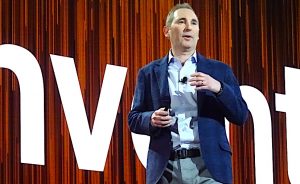 CLOUD
CLOUD
 CLOUD
CLOUD
 CLOUD
CLOUD
Technology giant Siemens AG hires 35,000 people each year, sorting through some 2 million applicants for positions in 120 countries in 20 languages. Search is essential to such a massive recruiting process, but language, cultural and industry differences have long been a problem in matching candidates to available positions.
“I might be looking for a software developer and I’m getting applications for a business developer,” said Stephanie Morton, Siemens’ Singapore-based global talent acquisition manager. As a result, the company’s 400 recruiters had to do much of the weeding-out and matching process manually.
Early this year, Siemens’ cloud recruiting partner, Jibe Inc., suggested that a new cloud service being tested by Google LLC’s Cloud Platform called Cloud Talent Solution could help. Leveraging Google’s expertise in translation, search and machine learning, the software improves the quality of candidate matches over time to cut down on waste and free up recruiters from drudge work. Siemens went live with it in April.
“It was like turning on a light switch,” Morton said. The number of web visitors who submitted applications jumped 30 percent almost immediately. For difficult-to-fill positions such as sales, the uplift was 50 percent, and people were now applying for the right positions. “This flipped our relationship from being about how we can perform better on their pages to how they can help us perform better and improve the candidate experience,” Morton said.

Siemens’ Morton: “It was like turning on a light switch” (Photo: LinkedIn)
Siemens’ use of Cloud Talent Solution highlights a sweeping move by cloud infrastructure-as-a-service providers to seize new ground in information technology. Having spent the past decade convincing customers that their existing data center workloads can run more reliably and securely in the cloud, these companies are now bidding for a bigger piece of the enterprise pie.
As the business of provisioning raw server capacity has become a commodity, cloud providers are moving up the value chain into line-of-business services that in some cases look a lot like those typically delivered by software-as-a-service providers. They’re rolling out new services such as “internet of things” development platforms, analytics, talent management suites, business planning frameworks and even robotic call center applications to customers that increasingly would rather buy than build.
The upshot: As thousands of Amazon Web Services Inc. customers flock to Las Vegas this week for the cloud giant’s annual re:Invent conference, the decade-old cloud infrastructure industry stands on the threshold of a major transition from rented infrastructure to strategic enterprise resource. Within five years, many experts believe, enterprises will build and run only a fraction of their own applications. Many of those tasks will be taken on by cloud providers that have the benefit of resources, experience and data that few of even the largest companies can match.
In turn, that’s starting to transform the companies shrugging off decades of in-house information technology in favor of the cloud. Indeed, the trend points to a potential change in the very meaning of a corporation. Twenty-five years after venture capitalist William Davidow wrote about the emerging “virtual corporation” offloading more and more of its noncore operations, the coming of age of cloud computing hints that it may finally become a reality.
And as businesses start to dispense with expensive gear and software that’s hard to maintain and operate, they can double down on their core business and even extend into new markets more quickly. Among companies that are moving to the cloud, AWS Chief Executive Andy Jassy said in an interview this week with SiliconANGLE, “the level of new ideas they get from all areas and all levels of the organization is astronomically different from what had been the case before.”
In the first stages of cloud adoption, “private and public clouds were basically VM vending machines,” said David Bartoletti, vice president and principal analyst at Forrester Research Inc., referring to the rented virtual machines, or computers emulated in software, called server instances. “Developers now want a whole collection of services they can use to assemble applications.”
The result could be an acceleration of the already torrid growth pace of the public cloud and software-as-a-service industries. More important, as cloud computing reaches what Forrester calls its “young adult years,” enterprises will begin to make a fundamental change in how they build software. In the future, new applications will be assembled from an increasingly rich palette of services offered by cloud providers.
“The trend will be to move more cloud services toward where the business actions takes place,” said Peter Burris, chief research officer and general manager of Wikibon, SiliconANGLE’s research arm. “Cloud is going to be the basis of innovation in the future.”

Amazon’s Jassy: “This isn’t just a migration.” (Photo: Robert Hof/SiliconANGLE)
AWS has been leading the charge, introducing 1,300 new services and features in 2017 alone and likely more than 1,800 this year, as well as several thousand behind-the-scenes technology deployments, according to Jassy. “More and more companies are rethinking how they do compute,” he said. “This isn’t just a migration from what they’ve been doing but net new opportunities.”
Microsoft is leveraging its deep ties with enterprise customers to identify new cloud services. The company, No. 2 behind AWS in cloud infrastructure services, told SiliconANGLE that the cloud provides companies with the ability to recognize patterns, acquisitions, secure data management and more efficiently connect supply chain activities. That’s spurring rising demand for the cloud’s more integrated services.
Several factors are driving the shift of cloud infrastructure companies into more strategic roles. IBM Corp. Fellow Bala Rajaraman estimates that only about 20 percent of enterprise workloads have moved to the cloud so far. New technologies are rapidly emerging that are making it possible for companies either to shift those remaining legacy applications in their entirety or to extend them with cloud services.
For example, the Representational State Transfer application program interface can be used to surround existing applications with cloud services that improve functionality and user engagement without requiring wholesale restructuring.
“The proliferation of the REST API is one of the most powerful things that’s happened in technology in the last 20 years,” said Miles Ward, director of solutions for Google LLC’s Cloud Platform. He cited the example of one customer’s package-tracking application that was enhanced by a real-time map interface through the simple addition of an API call to a web service.
The rapid adoption of containers, which are miniature portable virtual machines that include all the services an application needs to run, are easing customer concerns about getting locked into using a single cloud provider and enabling them to build more flexible applications from collections of cloud services, known as microservices. The Kubernetes container orchestration platform makes it possible to deploy and scale those applications with confidence.
The successes of early cloud adopters are also drawing in fast followers. They’re looking enviously at companies such as Capital One Financial Corp., which was one of the first to go all-in on cloud in 2015. Today it’s considered a leader in the application of IT to banking, and it’s even developing commercial software. Capital One is “radically transforming their business from being a bank with an IT department to a technology company that happens to sell credit cards,” said Forrester’s Bartoletti.
As cloud providers develop functional and vertical market expertise from working with an expanding number of customers, organizations will increasingly see value in handing over business functions, not just infrastructure. “As enterprises more fully embrace the cloud, they will begin to seek out specialized cloud services to meet specific technical and business needs,” said Murli Thirumale, co-founder and CEO of Portworx Inc., a developer of software for managing software containers.
For example, the Ancestry LLC DNA network recently signed up for IBM’s Planning Analytics as-a-Service for its own business planning and forecasting. Bloomberg LLC is using Google’s Translate to synthesize incoming information written in 40 languages. Google said its “Contact Center AI” service already had 800 customers by the time it launched into alpha testing in July.
Early this month, Gap Inc. said it will migrate hundreds of applications to the Microsoft Corp. Azure cloud platform with the intention of using Microsoft analytics and machine learning to improve personalization of customer experiences. General Electric Co. is also partnering with Microsoft to adopt Azure as the basis for its industrial IoT analytics products.
The Pac-12 Conference, an association of collegiate athletic programs, just selected AWS as its standard for machine learning and media workloads. Pac-12 already runs its media infrastructure in the AWS cloud, but it’s now setting up new production workflows to add live video-on-demand and web streaming services, as well as to deploy machine learning models that identify highlight clips and deliver closed captioning in real time.

Google’s Ward: “Businesses see cloud as a path to reduction of risk.” (Photo: Google)
“That means our engineers have a lot more time to focus on building things that affect our fans or help us save money,” said Mark Kramer, vice president of engineering and technology at Pac-12 Networks, the content arm of the Pac-12 Conference. “What we’re not doing is spending a lot of time updating servers, dealing with hardware that’s failing internally or fixing a hard drive.”
Going to the cloud has enabled Pac-12 Networks to cut its costs for international delivery from hundreds of thousands of dollars to pennies. Now it’s moving tasks, such as video editing, that were once thought to be strictly the domain of on-premises infrastructure to the cloud as well. Latency issues are more than canceled out by productivity gains enabled by cloud providers’ massive computing power, and “any week, there’s a new software release that will give us new functionality that we didn’t have to run an update to do,” Kramer said.
The goal of the network’s engineering team is now “to get as much as we possibly can into the cloud,” he said. “The [total cost of ownership] of this stuff has beaten anything else that we’ve been able to come up with.”
Google’s Ward said a lot of his company’s new customers are coming to the same conclusion. “Businesses see cloud as a path to reduction of risk,” he said. “If I can partner with a cloud provider that’s investing billions of dollars in what I need, that’s a natural option.”
Underlying all of these trends is the scramble by businesses of all types to make data the centerpiece of operational efficiency and customer engagement, a process often called digital transformation. A key goal is to simplify software development by making it easier for organizations to build applications out of preconfigured building blocks, many of which will come from cloud providers.
“Enterprises are laying down the digital transformation platforms they’re going to use for the next 10 years, and they’ll be a heavy mix of functions and services that are assembled” rather than built from scratch, said Forrester’s Bartoletti.
The key to digital transformation “won’t be custom software as much as customized composition,” Craig Lowery, a research director at Gartner Inc. “You’ll call to an API to tell you what it’s going to cost to ship a package. Developers will build more by composing.”
All that means cloud infrastructure providers will increasingly become intertwined with the IT operations of their customers, taking responsibility for functions that those customers don’t deem to be either strategic or a core competence. IT organizations will spend less time tending to servers and more time managing a fabric of cloud-delivered services. “Our usage of IT will change profoundly,” Lowery said. “There will be a lot less self-developed software running on VMs and a lot more SaaS.”
Could there also be a lot more lock-in? For veterans of the days when customers’ reliance upon proprietary systems and software sometimes made them hostage to draconian upgrade and maintenance fees, the prospect of allying too closely with particular cloud vendors brings back unpleasant memories.
“Where you get into trouble is when you start to stitch together machine learning with big data and then build a lot of applications using functions that are native to each public cloud,” said Wes Mukai, chief technology officer at GE’s Transportation Digital Solutions. “If, for some reason, you need to run the application in your data center, you’re into a 12- to 18-month replatforming effort.”
Experts say lock-in scenarios will be more plausible as vendors expand their range of services, but by insisting upon open platforms and standards, customers can keep their options open. “I don’t know if cloud providers think about lock-in; I think they’re thinking more about attracting customers,” said Lowery. “They have to have enough compelling value that customers will lock in.”
The business value of committing to a preferred cloud provider whose competencies match a customer’s own may well offset any risks of being tied down. “The fear of lock-in can paralyze a company’s business strategy, which is a much greater risk in the current environment where time-to-market is a critical success factor,” said Sam Kroonenburg, CEO of A Cloud Guru Ltd.
Agreed Bartoletti, “If you’re worried about lock-in, you’re probably too late.”
As IaaS providers move up the value stuck, customers will have some new choices to make about whom to align with.
Outside of Amazon, it appears few cloud providers will try to do it all. They’re more likely to align their business-focused services with their expertise in other areas, such as Amazon in retail, Microsoft in software development and Google in analytics and machine learning. “It’s all about information, and that’s why I say Google is the modern enterprise company,” Google Cloud CEO Diane Greene (who is stepping down from the job in January), told SiliconANGLE a few months ago. “We take information, we organize it and we supercharge it.”
Technologies such as microservices, containers and serverless computing will make it possible for customers to mix and match functions from different cloud providers to essentially construct applications out of piece parts. “The internet is the new development platform,” said Lowery.
“A lot of people would like to build on capabilities like Amazon’s Alexa to make their applications voice-activated,” said Jeff Kaplan, managing director of ThinkStrategies Inc., a consulting firm that specializes in on-demand computing services.

Microsoft’s Nadella: “Microsoft is evolving Azure to serve as ‘the world’s computer.'” (Photo: Microsoft)
Besides the big three cloud infrastructure vendors – Amazon, Microsoft and Google — other providers will become more specialized. “Oracle Cloud will be the best place to move and modernize Oracle databases. IBM will be the manager of multiple clouds,” said Bartoletti. “We will see a lot less of trying to make clouds bigger and better and more about being best at a particular industry.”
“It’s all about information, and that’s why I say Google is the modern enterprise company,” Greene said. “We take information, we organize it and we supercharge it. That’s what every business needs to do
As infrastructure providers move more aggressively into business services, there’s also a risk that they can come into conflict with SaaS providers such as Salesforce.com or Workday Inc., some of which may even run upon their platforms. “If history is any indication, expect Amazon to compete with every company at some point in the future,” Kroonenburg said.
Microsoft, whose CEO Satya Nadella has said the company aims to “evolve Azure to serve as ‘the world’s computer,'” claims to be the world’s largest cloud provider when its giant SaaS business is factored into the equation. However, the company claims to have intentionally kept the businesses functionally separate in an effort to cultivate the 7,000 new cloud partners that join its network each month. “Our apps serve a specific niche that complements a business, whereas Azure is a platform to help businesses with logistics and data,” a spokesman said. “Azure cements ownership in the hands of the enterprise, whereas our SaaS platform is an alternative for those who may not necessarily want to handle software infrastructure.”
For AWS’ part, Jassy told SiliconANGLE the company will move carefully, chiefly in response to customer demand, such as the Connect contact center introduced a year ago. But he acknowledged, “I think you can expect us to continue to build a little bit further up the stack.”
The clash appears to be inevitable, but the upside is that customers should benefit from greater choice. “The line between IaaS, [platform-as-a-service] and SaaS has blurred,” said ThinkStrategies’ Kaplan. “Vendors in each segment recognize that they need to have all three.”
Google’s Ward dismissed the conflict issue as minor. “I wouldn’t assume that just because Google competes with me, it’s going to be the end,” he said. Ward noted that Vimeo Inc., for instance, chose Google despite the cloud provider’s ownership of rival video-sharing service YouTube. “They’re still hugely successful in their market,” Ward said of Vimeo.
And SaaS vendors stand to gain from the same expanded services that infrastructure providers are offering to customers, Lowery said. “The hyperscalers are providing SaaS companies with almost immediate time to value,” he said. “Times have never been better for software vendors than they are now.”
Or, arguably, for their customers. As cloud exits adolescence, organizations will find themselves with an embarrassment of options for assembling and customizing applications. They’ll be able to mine rich data stores to training machine learning algorithms constructed on frameworks built by the best minds in artificial intelligence.
The winners will be those that move quickest to filter, choose and apply the best resources from multiple cloud providers. They’ll spend less time searching for skills and maintaining aging code and more time on innovation.
A troika of technology forces — data center transformation, application portability and cloud maturation — are set to change the way businesses compete. And the cloud, in particular, seems likely to enable that transformation to happen more quickly than many might expect. Waiting for the winners to emerge isn’t an option.
With reporting from Robert Hof and John Furrier
THANK YOU